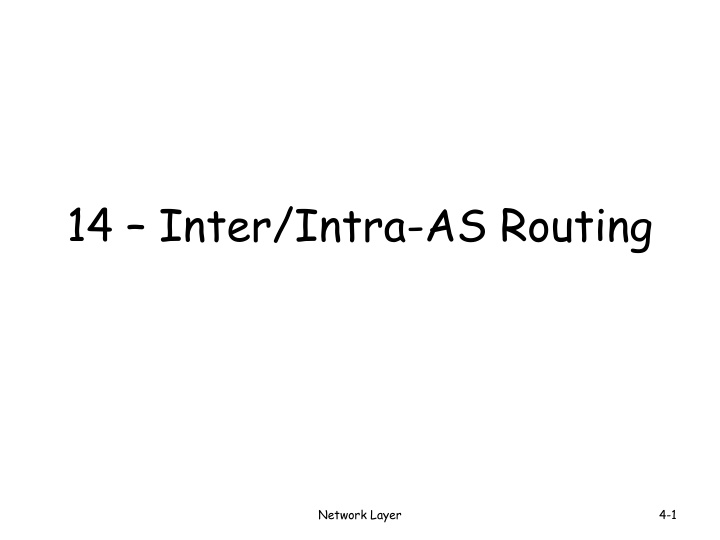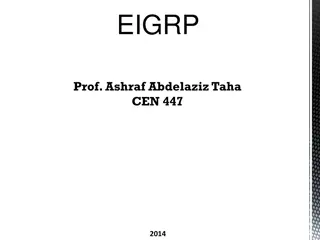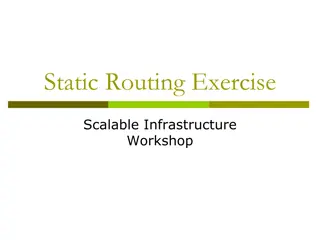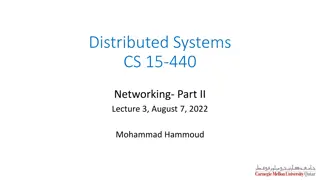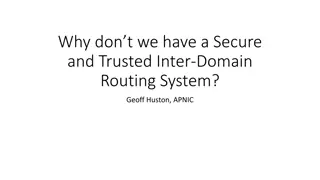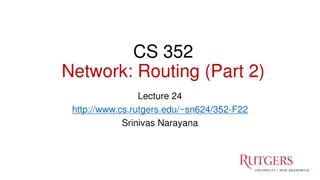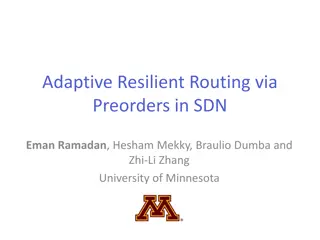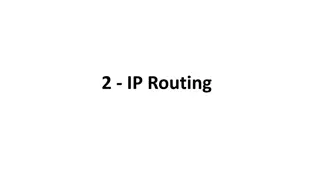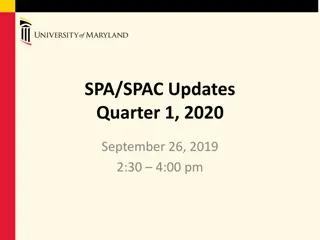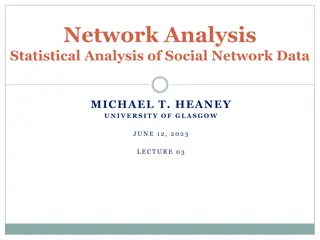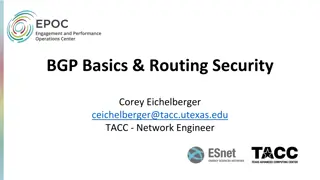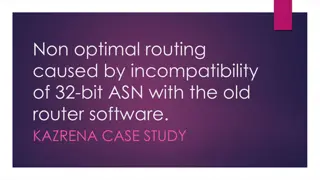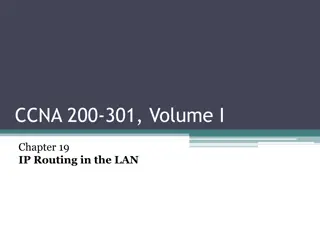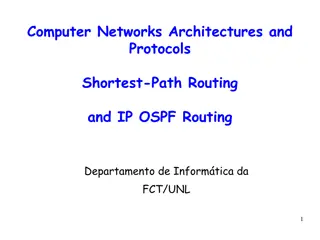Hierarchical Routing in Computer Networks
Hierarchical routing in computer networks involves organizing routers into regions known as autonomous systems (AS). This approach enables efficient routing by aggregating routers and allowing different AS to run their own intra-AS routing protocols. Interconnected ASes utilize both intra- and inter-AS routing algorithms to configure forwarding tables for optimal data packet routing across networks.
Download Presentation

Please find below an Image/Link to download the presentation.
The content on the website is provided AS IS for your information and personal use only. It may not be sold, licensed, or shared on other websites without obtaining consent from the author.If you encounter any issues during the download, it is possible that the publisher has removed the file from their server.
You are allowed to download the files provided on this website for personal or commercial use, subject to the condition that they are used lawfully. All files are the property of their respective owners.
The content on the website is provided AS IS for your information and personal use only. It may not be sold, licensed, or shared on other websites without obtaining consent from the author.
E N D
Presentation Transcript
14 Inter/Intra-AS Routing Network Layer 4-1
Hierarchical Routing Our routing study thus far - idealization all routers identical network flat not true in practice scale: with > 200 million destinations: can t store all dest s in routing tables! routing table exchange would swamp links! administrative autonomy internet = network of networks each network admin may want to control routing in its own network 4-2
Hierarchical Routing aggregate routers into regions, autonomous systems (AS) routers in same AS run same routing protocol intra-AS routing protocol routers in different AS can run different intra-AS routing protocol gateway router at edge of its own AS has link to router in another AS 4-3
Interconnected ASes 3c 3a 2c 3b 2a AS3 2b 1c AS2 1a 1b AS1 forwarding table configured by both intra- and inter-AS routing algorithm intra-AS sets entries for internal dests inter-AS & intra-As sets entries for external dests 1d Intra-AS Routing algorithm Inter-AS Routing algorithm Forwarding table 4-4
Inter-AS tasks AS1 must: 1. learn which dests are reachable through AS2, which through AS3 2. propagate this reachability info to all routers in AS1 job of inter-AS routing! suppose router in AS1 receives datagram destined outside of AS1: router should forward packet to gateway router, but which one? 3c 3a 3b 2c AS3 other networks 1c 2a 2b other networks 1a 1b AS2 1d AS1 4-5
Intra-AS Routing also known as Interior Gateway Protocols (IGP) most common Intra-AS routing protocols: RIP: Routing Information Protocol OSPF: Open Shortest Path First IGRP: Interior Gateway Routing Protocol (Cisco proprietary) 4-6
RIP ( Routing Information Protocol) included in BSD-UNIX distribution in 1982 distance vector algorithm distance metric: # hops (max = 15 hops), each link has cost 1 DVs exchanged with neighbors every 30 sec in response message (aka advertisement) each advertisement: list of up to 25 destination subnets (in IP addressing sense) from router A to destination subnets: subnet hops u 1 v 2 w 2 x 3 y 3 z 2 u v w A B x C D z y 4-7
RIP: Example z y w x B D A C routing table in router D destination subnet w y z x . next router # hops to dest A B B -- . 2 2 7 1 .... 4-8
RIP: Example A-to-D advertisement dest next hops w x z . - 1 - 1 C 4 ... z y w x B D A C routing table in router D destination subnet w y z x . next router # hops to dest A B B -- . 2 2 7 1 .... 5 A 4-9
RIP: Link Failure and Recovery If no advertisement heard after 180 sec --> neighbor/link declared dead routes via neighbor invalidated new advertisements sent to neighbors neighbors in turn send out new advertisements (if tables changed) link failure info quickly (?) propagates to entire net poison reverse used to prevent ping-pong loops (infinite distance = 16 hops) 4-10
RIP Table processing RIP routing tables managed by application-level process called route-d (daemon) advertisements sent in UDP packets, periodically repeated routed routed Transport (UDP) Transprt (UDP) network forwarding (IP) table network (IP) forwarding table link link physical physical 4-11
OSPF (Open Shortest Path First) open : publicly available uses Link State algorithm LS packet dissemination topology map at each node route computation using Dijkstra s algorithm OSPF advertisement carries one entry per neighbor router advertisements disseminated to entire AS (via flooding) carried in OSPF messages directly over IP (rather than TCP or UDP) 4-12
OSPF advanced features (not in RIP) security: all OSPF messages authenticated (to prevent malicious intrusion) multiple same-cost paths allowed (only one path in RIP) integrated uni- and multicast support: Multicast OSPF (MOSPF) uses same topology data base as OSPF hierarchical OSPF in large domains. 4-13
Hierarchical OSPF boundary router backbone router backbone area border routers Area 3 internal routers Area 1 Area 2 4-14
Hierarchical OSPF Two-level hierarchy: local area, backbone. Link-state advertisements only in area each node has detailed area topology; only know direction (shortest path) to nets in other areas. Area border routers: connect to the backbone and thus other areas. Backbone routers: route traffic between areas. Boundary routers: connect to other AS s. Network Layer 4-15
Internet inter-AS routing: BGP BGP (Border Gateway Protocol): the de facto inter-domain routing protocol glue that holds the Internet together BGP provides each AS a means to: eBGP: obtain subnet reachability information from neighboring ASs. iBGP: propagate reachability information to all AS-internal routers. determine good routes to other networks based on reachability information and policy. allows subnet to advertise its existence to rest of Internet: I am here 4-16
BGP basics BGP session: two BGP routers ( peers ) exchange BGP messages: advertising pathsto different destination network prefixes ( path vector protocol) exchanged over semi-permanent TCP connections when AS3 advertises a prefix to AS1: AS3 promises it will forward datagrams towards that prefix AS3 can aggregate prefixes in its advertisement 3c BGP message 3a 3b 2c AS3 other networks 1c 2a 2b other networks 1a 1b AS2 1d AS1 4-17
BGP basics: distributing path information using eBGP session between 3a and 1c, AS3 sends prefix reachability info to AS1. 1c can then use iBGP to distribute new prefix info to all routers in AS1 1b can then re-advertise new reachability info to AS2 over 1b-to-2a eBGP session when router learns of new prefix, it creates entry for prefix in its forwarding table. eBGP session 3a iBGP session 3b 2c AS3 other networks 1c 2a 2b other networks 1a 1b AS2 1d AS1 4-18
Path attributes & BGP routes When advertising a prefix, advert includes BGP attributes. prefix + attributes = route Two important attributes: AS-PATH: contains the ASs through which the advert for the prefix passed: AS 67 AS 17 NEXT-HOP: Indicates the specific internal-AS router to next-hop AS. (There may be multiple links from current AS to next-hop-AS.) When gateway router receives route advert, uses import policy to accept/decline. Network Layer 4-19
BGP route selection Router may learn about more than 1 route to some prefix. Router must select route. Elimination rules: 1. Local preference value attribute: policy decision 2. Shortest AS-PATH 3. Closest NEXT-HOP router: hot potato routing 4. Additional criteria Network Layer 4-20
BGP messages BGP messages exchanged between peers over TCP connection BGP messages: OPEN: opens TCP connection to peer and authenticates sender UPDATE: advertises new path (or withdraws old) KEEPALIVE: keeps connection alive in absence of UPDATES; also ACKs OPEN request NOTIFICATION: reports errors in previous msg; also used to close connection 4-21
BGP routing policy legend: provider network B X W A customer network: C Y A,B,C are provider networks X,W,Y are customer (of provider networks) X is dual-homed: attached to two networks X does not want to route from B via X to C .. so X will not advertise to B a route to C 4-22
BGP routing policy (2) legend: provider network B X W A customer network: C Y A advertises path AW to B B advertises path BAW to X Should B advertise path BAW to C? No way! B gets no revenue for routing CBAW since neither W nor C are B s customers B wants to force C to route to w via A B wants to route only to/from its customers! 4-23
Why different Intra- and Inter-AS routing ? Scale: hierarchical routing saves table size, reduced update traffic Performance: Intra-AS: can focus on performance Inter-AS: policy may dominate over performance Network Layer 4-24
Network Layer: summary What we ve covered: network layer services routing principles: link state and distance vector hierarchical routing IP Internet routing protocols RIP, OSPF, BGP what s inside a router? IPv6 Next stop: the Data link layer! Network Layer 4-25
